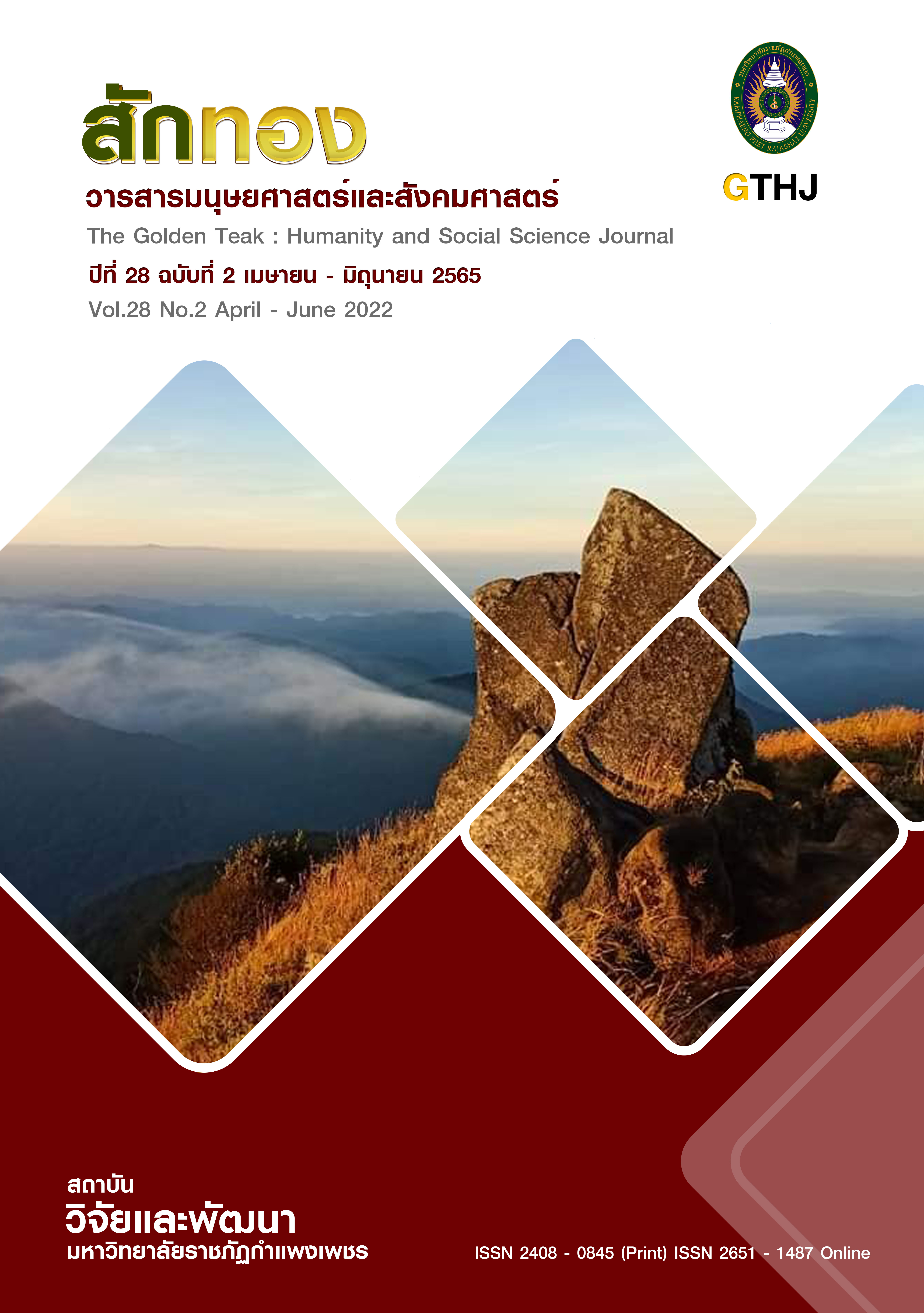The Effects of Blended Learning Based on 3CM (Cool-Critical-Creative-Meaningful) Model on Creative Problem Solving Ability in Fraction for Grade 7 Students
Main Article Content
Abstract
This research aimed to study the creative problem-solving ability in fraction for grade 7 student between and after learning through the blended learning based on the 3CM (Cool-Critical-Creative-Meaningful) model. The target group were 35 of grade 7 students in a school, Kamphaeng Phet Province. This is a classroom action research. Research tools include lesson plans, activity sheets with the average of appropriateness of 4.49 and creative problem-solving ability test with the Item Objective Congruence (OIC) Index is 1.00. Data were analyzed by content analysis. The results revealed that most of students were in very good level of creative problem solving ability. Namely, students can find the fact and find the asked question in very good level, while they can find strategy for problem solving and can find problem solving processes and can create new knowledge in good level
Article Details

This work is licensed under a Creative Commons Attribution-NonCommercial-NoDerivatives 4.0 International License.
บทความที่ได้รับการตีพิมพ์เป็นลิขสิทธิ์ของวารสาร สักทอง : วารสารมนุษยศาสตร์และสังคมศาสตร์ สถาบันวิจัยและพัฒนา มหาวิทยาลับราชภัฏกำแพงเพชร
ข้อคิดเห็นใดๆ ที่ปรากฎในวารสารเป็นวรรณกรรมของผู้เขียนโดยเฉพาะ ซึ่งมหาวิทยาลัยราชภัฏกำแพงเพชรและบรรณาธิการไม่จำเป็นต้องเห็นด้วย
References
Harvey, R. & Averill, R. (2012). A Lesson Based on the Use of Contexts: An Example of Effective Practice in Secondary School Mathematics. Mathematics Teacher Education and Development, 14(1), 41-59.
Kadir, Anggo, M., Masi, L., Misu, L., & Sani, A. (2015). Coastal context in learning mathematics to enhance mathematical problem solving skills of secondary school students. Department of Mathematics Education Halu Oleo University, Indonesai.
Khamnan, S. (2009). Effects of Blended Learning with Discovery Learning Approach Using Inductive and Deductive Methods upon Self-Efficacy in Mathematics Subjects of Ninth Grade Students with Different Mathematics Learning Ability Levels. Master’s thesis, Chulalongkorn University.
Kiokaew, S. (1997). Science Teaching in Secondary Level. Pattani : Faculty of Education. Prince of Songkla University (Pattani Campus).
Isrok’atun. & Tiurlina. (2014). Enhancing students’ mathematical creative problem solving ability through situation-based learning. Mathematical Theory and Modeling, 4(11), 44-49.
Noipinit, P, Supap, W. & Klineam, C. (2019). Action Research on Developing Learning Management in the topic of Conic Sections using Design Thinking Process to enhance Creative Problem Solving Competency of Students in Grade 10. Journal of Rangsit University: Teaching & Learning, 13(1), 70-84.
Ozdemir, Ahmet Sukru. (2009). The Effects of Multiple Intelligence Approach in Project Based Learning on Mathematics Achievement. International Online Journal of Educational Sciences, 1(1), 177-195.
Patthanatrakulsuk, K. (2003). The Failure Study in Mathematics for Secondary Level in Thailand. Mathematical Journal, 46(530-535), 54-58.
Ramsiri, R. (2013). The Development of Science Instructional Model by Using Research-Based to Enhance Research Skills, Creative Problem-Solving Skills, and Scientific Minds of Secondary School Students. Doctoral dissertation, Silpakorn University.
Thammabus, M. (2002). The Development of Quality Learning by Using PBL (Problem-Based Learning). Academic, 2, 11-17.
The Institute for the Promotion of Teaching Science and Technology. (2015). Research Report of Project TIMSS 2015. Bangkok: The Institute for the Promotion of Teaching Science and Technology.
The Institute for the Promotion of Teaching Science and Technology (IPST) Govermemt Building. (2019). PISA 2018 Results: Reading and Science. n.p. : The Institute for the Promotion of Teaching Science and Technology (IPST).
The Institute for the Promotion of Teaching Science and Technology. (2004). Reasoning in mathematics at the level of Primary education according to the core curriculum of basic education 2001. Bangkok : S.P.N. Printing Company.
Thipkong, S. (2001). The Mathematical Problem Solving. Bangkok : Center of Book Development, Department of Academic, Ministry of Education.
Thipkong, S. (2008). The Aim of Mathematics Study. Mathematical Journal, 53(599-601), 12-19.
Tinnangwattana, C. (2012). The Effect of Blended Learning Instructional Lesson Plans in Foods and Nutrient Title on Science for Mathayomsuksa II in Mathayomsuksa Wadsing School. Master’s thesis, Srinakharinwirot University.
Tonsuwanrat, O. (2009). Effects of Organizing Mathematics Learning Activities Using Creative Problem Solving Ability and Creative Thinking of Eight Grade Students. Master’s thesis, Chulalongkorn University.
Torrance, E.P. (1962). Guiding creative talent. NJ : Prentice-Hall.


